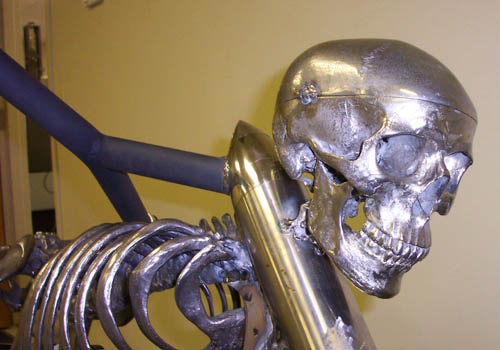
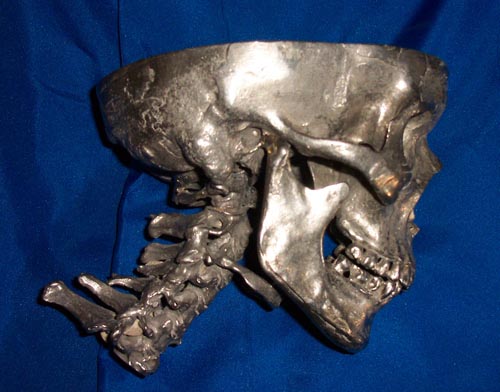
”Something wicked this way comes,” Snake, the Bikernet shop drunk said and ran for the bar.”
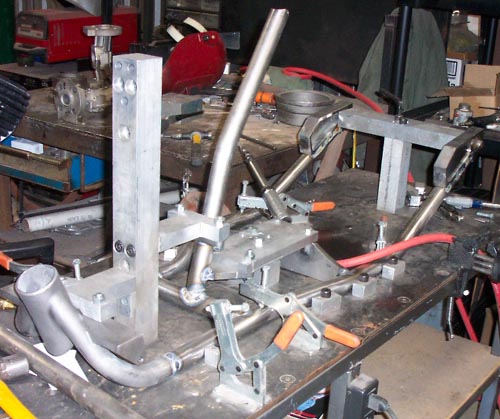
I didn’t know what to think, staring at my computer. I attempted code and edit all the new Buell models for 2006, but my computer sparked and whined like a bad wire on my ’48 Panhead. A messaged jumped onto the face of my screen.
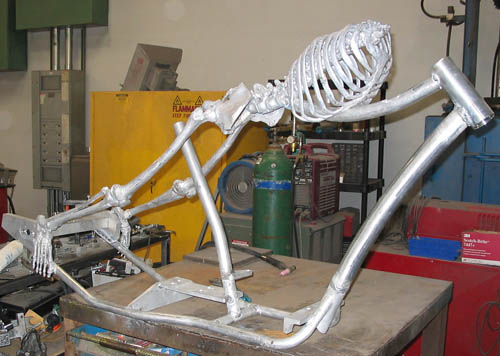
The phone rang with a dull jingle, as if it would be the last. “Skulls and bones are without a doubt a very popular theme from bikes to pirate ships. From truck paint jobs to motorcycle air cleaners, skulls and crossed bones seem to be everywhere,” Kelley said, John Farr IV’s wife. I didn’t recognize her voice, and the conversation ended as quickly as it started. I rubbed my eyes, stood up from my Panhead desk and stretched. Then I checked the ammo load in the .357 next to my file cabinent. Who the hell was that, I thought? Then it dawned on me. A name from the past resurfaced.
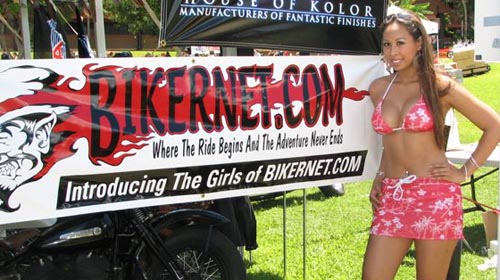
John III, John IV, and Herb Farr of The Crypt Custom Cycles in Opelika, Alabama came up with this crazed notion, designing a skeleton framed motorcycle. It was no bondo and paint or accessory sculpture but the real deal. He contacted me while at Primedia. His feature, I thought, was in the works. My computer blinked again and another mysterious message threatened. I needed to honor what I had promised behind the mag. I knew we could deliver the story behind the build, the construction, the accolades, the events and the final outcome. I answered his frustrated e-mail and Bikernet moved into action. Could the eerie skulls and death threats have anything to do with it? I won’t go there…

This frame was actually made in the form of a metal female skeleton. “We had run short of shallow graves behind the shop,” John said. “We had to do something with her bones.” The prototype bike was built from aluminum, but the family operation hopes to roll into production with titanium castings soon.
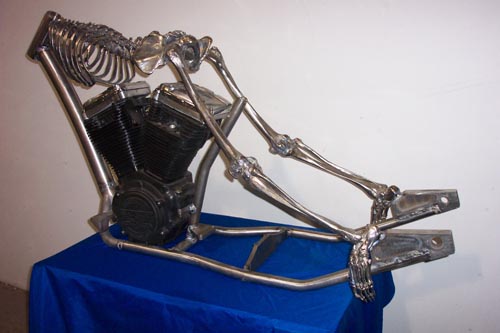
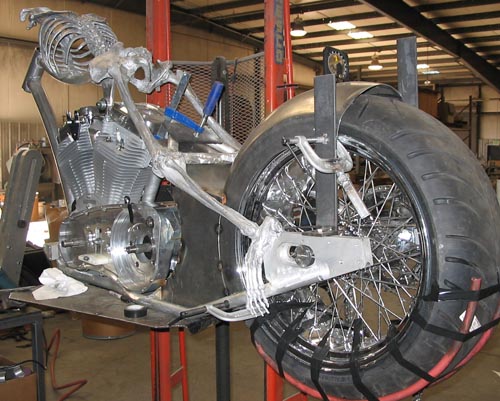
The idea started with a desire to create something truly unique in this market. The Crypt’s parent company is a specialty foundry; so dealing in obscure metal objects isn’t new to them.
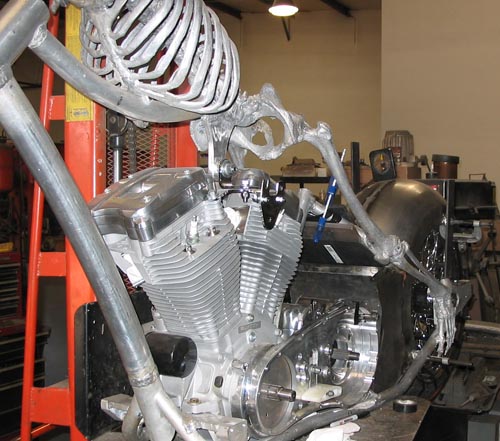
”A medical(?) skeleton was purchased, you know, the kind that hangs in the doctor’s office,” John’s wife interrupted, wiping the sweat off her rosey brow with a tissue, “and silicone rubber molds were made of each body part, so they could replicate the bones via lost wax casting.” With the cast bones on hand and after several months of layout and design work, the fabrication of the frame began.
A welding jig for the frame was built, tubing was bent to fit, and a few months later, a frame was complete. There were a few problems figuring out how the bones fit back together anatomically, but luckily, John IV’s wife, Kelley, is a radiology (x-ray) tech and could help in that area.
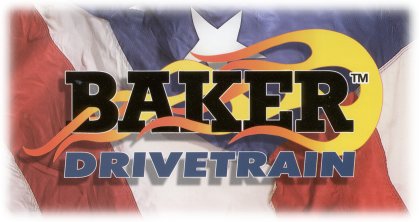
Since there is a rib cage where the fuel should go, an integrated gas tank/rear fender was fabricated starting with a Chopper’s, Inc. fender, with an effort not to complicate or distract from the design. A Baker Drop Starter Slam Clutch set up was installed to give more under seat room for the tank. A set of custom handlebars was bent to accentuate design and clear the bones.
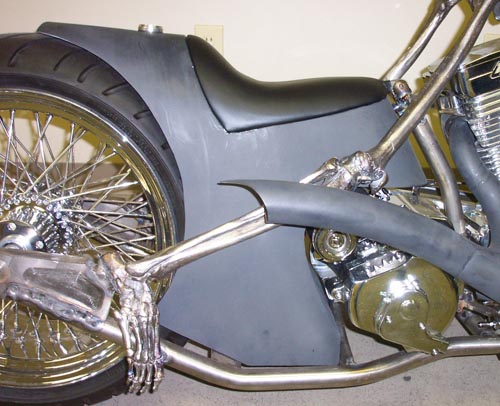
The oil tank started out in the downtube, but did not give enough capacity to cool the stock Harley Evolution, so an “oil bag” was created.
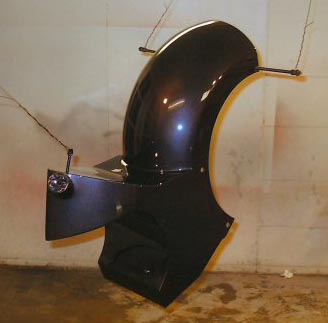
Next was the paint and finishing touches. Paint and bodywork was done at Conner’s Collision Center, also of Opelika. Bill Conner and crew worked day and night to finish so the bike could appear in Daytona. Rodney Estes laid down the rich paint combination of black with copper and blue pearls, and it came out beautifully.

A few gremlins in the reassembly caused a “no show” at Daytona, so the bike was taken to Thunder Beach in Panama City Beach, Florida for its debut. With many turned heads, points and stares, it was a hit! So, what now?
”On to Myrtle Beach Bike Week and from there, hopefully into production full time,” John IV said. “With many more bike rallies and shows left in the year, make plans to attend one so you can check out this awesome creation yourself (just check the web site to make sure they’ll be there). Ride out of the box.”
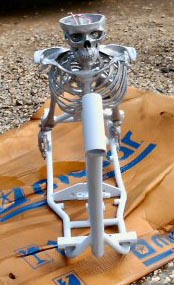
The family operation is designing a line of parts based on the skeleton, including mirrors that are hands holding coffins with a touch adjustable mirror inside, thigh bone ape hangers and, collarbone clutch and brake levers.
“ I also have a Confederate line of covers,” John said, “very clean modular forward controls, bar end reversed lever hand controls and the scythe front end on the titanium bike.”
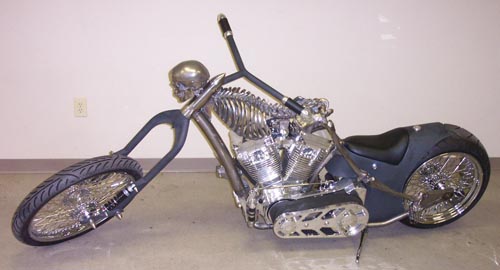
” I also have started designing an FX style bike that I am hoping to start at around $15,000. It will be a good handling, lightweight standard with more emphasis on go than show. It seems like there are few if any customs for bikers out there.”

Still I asked more questions which turned into an interview with John Farr:
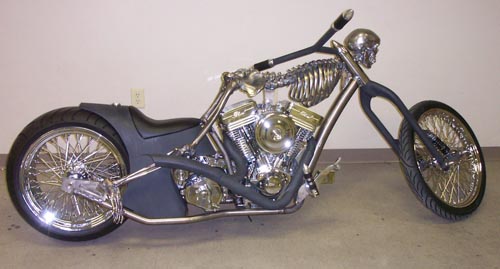
You said that most of the work is done by hand, using very few parts that weren't specifically tooled for the bike: Why is that?
This bike is a custom from the ground up. The frame was designed to allow a stock drivetrain to fit, but the shape of the skeleton required some creative space management. The skeleton is integral to the structure of the frame, but I wanted it to remain uncluttered. The rear fender houses the gas and oil tanks and all of the electronics except for the battery, which is under the transmission. I designed the treeless front end to clear the head and shoulders, and to allow the body to keep its form. Everything we built for the bike was designed to compliment the design and/or blend in, but still be functional. I want our customers to have a unique, personalized ride with parts designed for their bike.
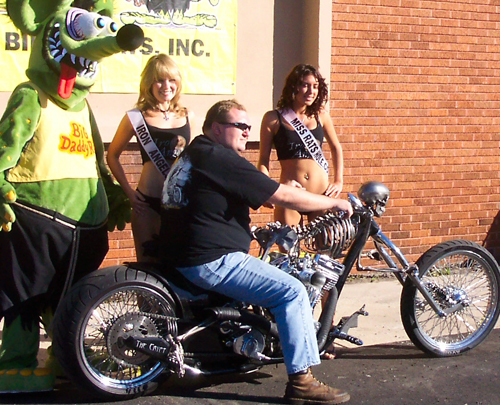
When we discussed the Crypt before, you pointed out that the skeleton was taken from life (I was careful not to ask whose life?) and cast in titanium. What all is involved in the process?
The titanium was cast using the investment, or lost wax, process. The model we used was an anatomy class skeleton (sure, sure). We broke it down into sections and made rubber molds from the bones. The molds were then hand filled with molten wax. After each wax piece hardened, it was coated with ceramic until a shell was formed around the part. The ceramic shells were heated to remove the wax and cured in an oven at 2000 degrees F. Then, molten titanium was poured into each shell inside a vacuum chamber. When the metal cooled, the ceramic was knocked off and the parts were ground and cleaned for welding.
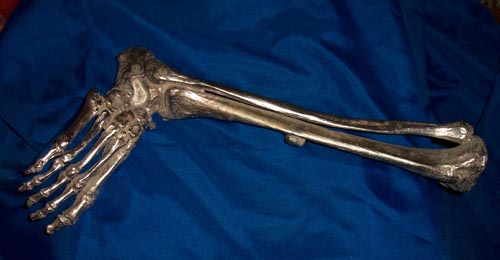
Why titanium instead of a less complicated metal?
The skeletal structure of the frame has some fairly thick and solid sections. We used titanium make the frame lightweight and retain the strength needed for big inch motors. The alloy we used has physical properties similar to steel, but weighs half as much. The frame weighs 62 pounds.
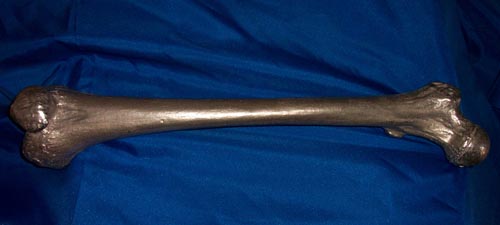
About how many hours of work goes into building each bike?
That’s hard to say, because a good portion of the time in this one was spent designing parts for it. It took about nine months, but I think I could build one in four to six months depending on the amount of design work for custom parts.
Tell us more about the FX style project?
I would like to build several different styles of bike. I do have some design work done on a FX type bike that will be affordable and built for riding. It will be light and fast with nothing on it that doesn’t need to be there, but can be built as plain or as radical as a customer wants. We are also coming out with a line of parts spun off from the skeleton bike.
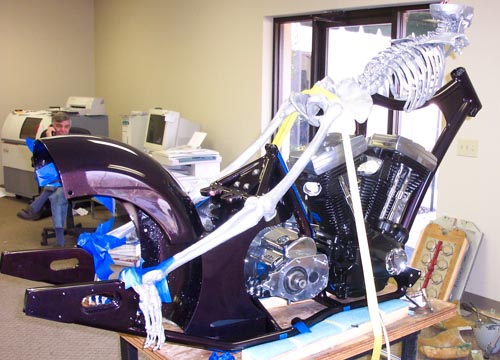
How did you get started in custom bike building?
I have always been a tinkerer. I started out with dirt bikes and jap bikes and always worked on my own stuff. I had the welding and fab experience from working in the foundry. I have always wanted to build and customize cars and bikes. I never had the time, when I had the money, or the money when I had the time. When my dad had the idea for the skeleton bike, I was hesitant at first because of the scope of the project, but once I got rolling, it all seemed to come together.
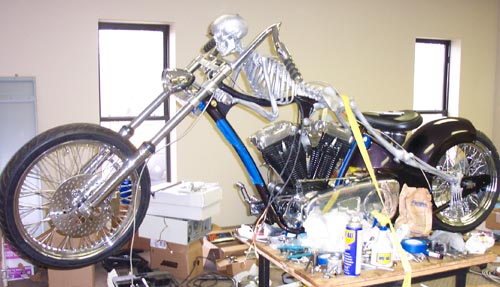
How much education did you need to get before you could work with the metals involved and how much was formal as opposed to an apprenticeship?
I have no formal training in any of this stuff. I am a fourth generation foundry man and have been around it for most of my life. I’ve been working in the foundry for ten years and learned as I moved along. In metal casting and bike building, or any other business for that matter, if you stop learning you’re not doing much of anything.
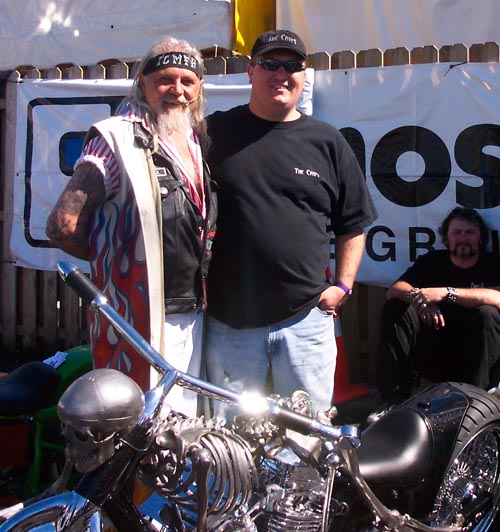
Do you plan on attending many shows?
Right now, I am working on getting our parts line up and running, and that’s taking a lot of time. We will continue to do as many shows as we can, but I think we may wait until we have parts in a catalog before we go hard after the show circuit.
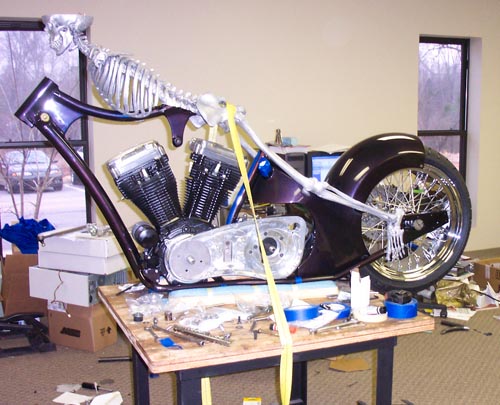
Tell us about your business in general, what else do you do?
On the foundry side, we cast all sorts of parts in just about any metal alloy. We are a small run and prototype shop that specializes in odd and unusual parts and alloys.
We handle work for other foundries and a lot of hard to cast parts that most shops turn down. We have an in-house machine shop that comes in handy with bike parts. On the bike shop side, we can build just about any bike you can dream up. We can create and build one-off parts to customer specs. As I said earlier, I am working on a line of parts the will include our Scythe front end that you see on this bike and many different skeletal parts like controls, mirrors and bars. We’ll have a catalog out before the end of the year, but we would also like to work with our customers to make the parts that they have floating in their heads.
What's a normal day like for you?
I don’t have normal days.
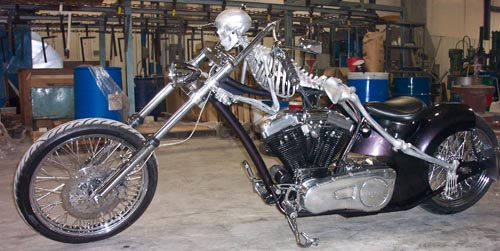
Fabrication: The Crypt
Assembly: The Crypt
Paint: O’s Custom Paints
Striping: Mike Robbins
Chrome: Reflections
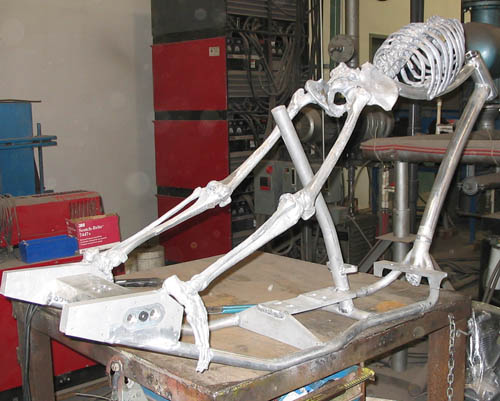
Frame: 2005 Crypt Custom Titanium
Sheet Metal: The Crypt
Engine: TP 121
Transmission: Baker 6 Speed RSD
Primary: BDL TF-2000
Front End: The Crypt
Shocks: Stratos
Wheels: Landmark
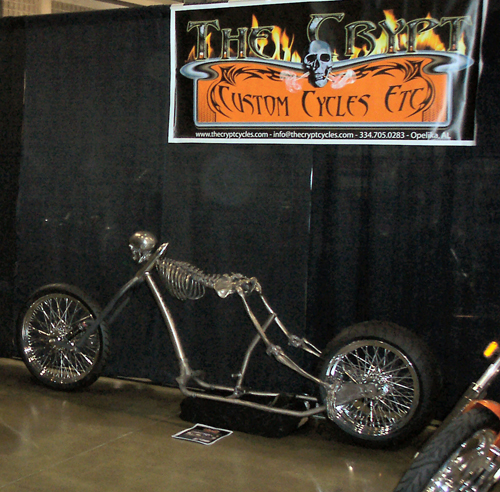
Tires: Avon Venom
Brakes: Exile Cycles
Throttle: Exile Cycles
Bars: The Crypt
Grips: The Crypt
Controls: The Crypt
Shifter: The Crypt
Headlight: The Crypt
Tail Light: Pro Fab
Velocity Stack: Northeastern Machining
Chain Tensioner: The Crypt
Seat: Rusty Black


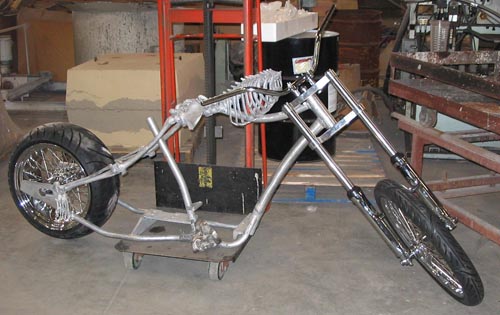
The prototype has the standard front end and solo seat. It is all aluminum. It's a lot cheaper to fuck up aluminum than titanium. It also has the head and neck above the risers. The original concept was to run the neck through the neck tube like the titanium bike, but I was concerned about strength at that joint.
Either design is available, or any other layout that fits within the confines of the skeleton. The bikes will start around $60,000 for an existing design.
I designed the leading link front end on the titanium bike without triple trees to clear the head and shoulders. It was drawn up as an inverted springer, but on a whim, I called a mountain bike shock builder. The coil over setup looks cool, and I haven't seen one quite like that. It will be available to the public as soon as my machining center is back up and running. (long story).
The one on the titanium bike is all fabricated from 4130, but from here on we'll incorporate some cast parts. The castings will make it lighter, and since it will have fewer welds, it will be stronger. It also handles quite well. There will be several rocker designs and lengths up to around six over for now. I'll have to do some testing for anything longer before I put somebody on one. Trail adjustments will be made with rocker length.
GENERAL
Fabrication: The Crypt
Year and Make: 2004 The Crypt
Model: Prototype
Assembly by: John Farr
Time: Seven Months
Chroming: Reflections
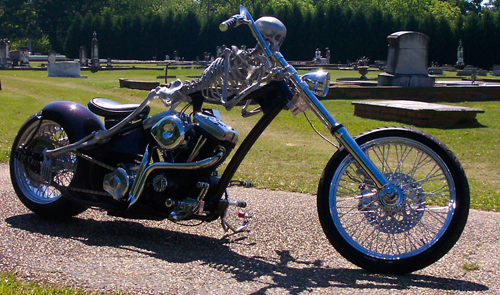
ENGINE
Year: 2003
Model: Harley Davidson Evolution
Rebuilder: N/A
Ignition: Crane
Displacement: 80 ci
Lower end: Stock
Balancing: N/A
Pistons: Stock
Cases: Stock
Heads: Stock
Cams: Stock
Lifters: Stock
Carb: S&S “Super E”
Air cleaner: S&S
Pipes: Santee

TRANSMISSION
Make: Baker
Model: Drop Starter Slam Clutch
Year: 2003
Type: Six-Speed Right Side Drive
PAINTING
Molding: Bill Conner and Crew at Conner’s Collision Center
Painter: Rodney Estes at Conner’s Collision Center
Color: Black
Type: PPG
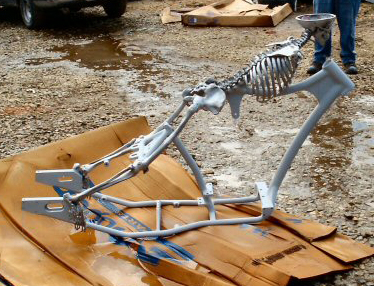
FRAME
Year: 2004
Builder: The Crypt
Type: Prototype
Rake: 40 Degrees
Stretch: Three Inches in Backbone (Not her backbone)
Other: Aluminum Tube and Cast Aluminum Skeleton
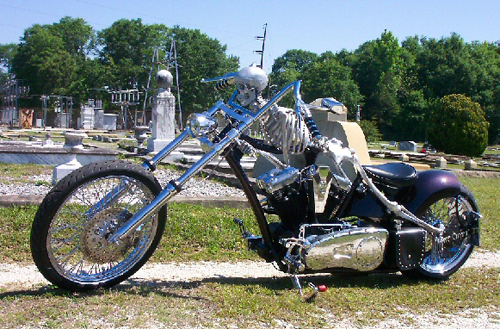
ACCESSORIES
Bars: The Crypt
Risers: Built In
Fenders: Choppers, Inc/The Crypt
Headlight: Adjure
Taillight: Drag Specialties
Speedo: N/A
Front Pegs: Legends
Rear Pegs: N/A
Electrics: Thunderheart
Gas Tank: The Crypt
Oil Tank: The Crypt
Oil System: Stock
Seat: LePera
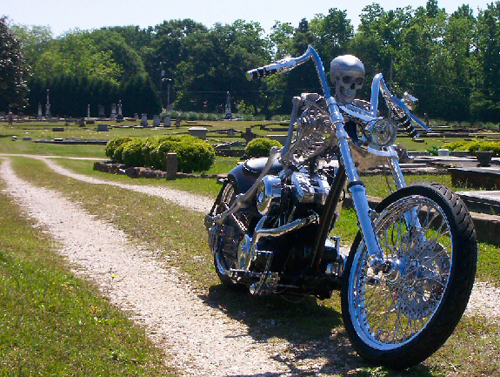
FORKS
Type: Standard
Extension: Two Inches Under
Builder: Custom Chrome
Special Features: N/A
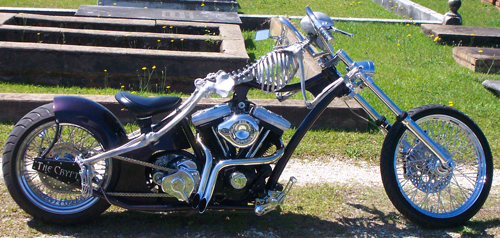
WHEELS AND TIRES
Front
Size: Avon Venom
Rim: 21 X 2.15 60 Spoke
Rear
Size: Avon Venom 250
Rim: 18 X 8.5 on 60 Spoke
John Farr
The Crypt Custom Cycles
2400 Industrial Boulevard
Opelika, AL 36801
www.thecryptcycles.com
john@thecryptcycles.com
334-705-0283 Phone
334-705-0390 Fax
334-663-2696 Cell
